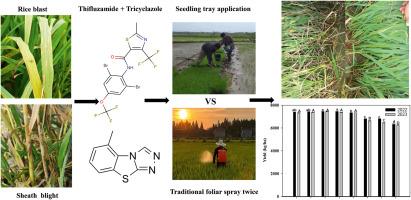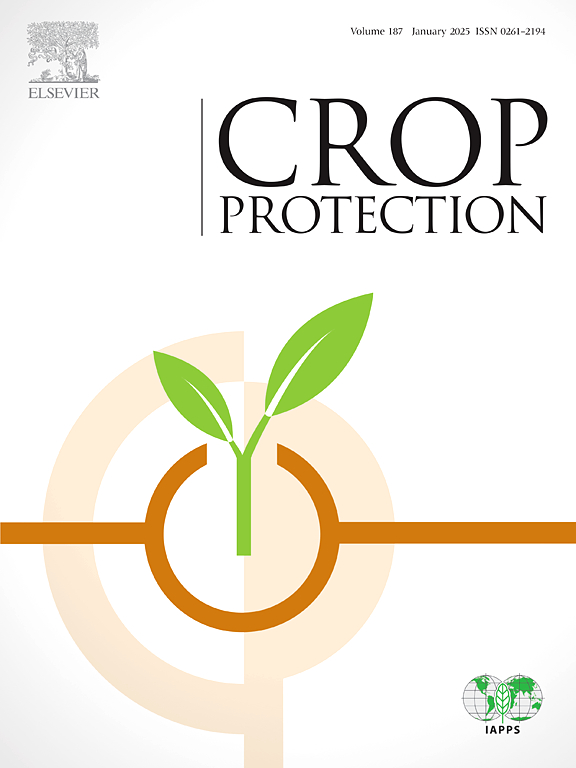在秧盘中施用噻虫嗪和三环唑综合防治稻瘟病和鞘枯病,节省劳动力
IF 2.5
2区 农林科学
Q1 AGRONOMY
引用次数: 0
摘要
稻瘟病(Magnaporthe grisea)和鞘枯病(Rhizoctonia solani)是限制水稻产量的因素。这些病原体的共同侵染导致了难以控制的复合病害。在中国,种植者习惯于使用单独的杀菌剂来防治稻瘟病和鞘枯病,这需要大量的劳动力。在育苗盘中施用杀菌剂是一种节省劳动力的新型解决方案。本研究在体外试验和田间试验中评估了在秧盘中施用不同作用模式的复合杀菌剂来综合防治稻瘟病和鞘枯病的效果。结果表明,噻虫嗪和三环唑以 1:2 的比例复配,对 M. grisea 和 R. solani 的菌丝生长有显著的增效抑制作用,增效比(SR)分别为 2.17 和 1.49。田间试验结果表明,噻虫嗪+三环唑1107克/公顷和958.5克/公顷施用于秧盘是降低稻瘟病发病指数最有效的处理方法,在2022年和2023年的防治效果分别为83.74-84.96%和81.34-83.26%,与三环唑300克/公顷叶面喷施两次的防治效果无显著差异。与未处理的对照相比,含氟虫酰胺的所有处理都显著降低了水稻鞘枯病的发病指数。对秧盘施用 1107 克/公顷的噻虫胺+三环唑处理的防治效果最高。此外,与未处理的对照相比,所有处理都显著提高了 2022 年和 2023 年的稻谷产量,增幅分别为 7.67-17.86% 和 3.38-18.91%。在秧盘中施用 1107 克/公顷的噻虫嗪+三环唑处理的产量最高(2022 年和 2023 年分别为 7429.73 千克/公顷和 7404.73 千克/公顷),而含有三环唑的所有处理之间没有显著差异。总之,这些结果表明,秧盘施用噻虫胺+三环唑是一种省力的方法,可综合防治稻瘟病和鞘病复合病害,同时提高水稻产量。本文章由计算机程序翻译,如有差异,请以英文原文为准。

Labor-saving application of thifluzamide and tricyclazole to seedling trays for integrated control of rice blast and sheath blight
Rice blast (Magnaporthe grisea) and sheath blight (Rhizoctonia solani) are limiting factors for rice production. Co-infection of these pathogens results in a disease complex which is difficult to control. In China, growers are accustomed to applying individual fungicides to manage blast and sheath blight, which require large amounts of labor. Application to seedling trays is a new promising solution for saving labor. In this study, application of combined fungicides with different modes of action to seedling trays to integrate control rice blast and sheath blight was evaluated in vitro assays and field trials. The results showed that the combination of thifluzamide and tricyclazole in the 1:2 ratio had significant synergistic inhibitory effects on the mycelial growth of M. grisea and R. solani, with a synergistic ratio (SR) of 2.17 and 1.49. Results from field trials revealed that thifluzamide + tricyclazole at 1107 and 958.5 g/ha applied to seedling trays was the most effective treatment to reduce the disease index of rice blast with control effects of 83.74–84.96% and 81.34–83.26% in 2022 and 2023, respectively, and no significant differences were observed from tricyclazole at 300 g/ha as foliar sprays twice. Compared to the untreated control, disease index of rice sheath blight was notably reduced by all treatments containing thifluzamide. The highest control was recorded in the treatment of thifluzamide + tricyclazole applied at 1107 g/ha to seedling trays. Moreover, compared to the untreated control, all treatments significantly enhanced rice grain yield by 7.67–17.86% and 3.38–18.91% in 2022 and 2023, respectively. The greatest yield (7429.73 and 7404.73 kg/ha in 2022 and 2023, respectively) was observed from the treatment of thifluzamide + tricyclazole at 1107 g/ha applied to seedling trays, with no significant differences among all the treatments containing tricyclazole. Taken together, these results indicated that seedling tray application of thifluzamide + tricyclazole could be a labor-saving approach to the integrated control of rice blast and sheath blight disease complex, while increasing rice grain yield.
求助全文
通过发布文献求助,成功后即可免费获取论文全文。
去求助
来源期刊

Crop Protection
农林科学-农艺学
CiteScore
6.10
自引率
3.60%
发文量
200
审稿时长
29 days
期刊介绍:
The Editors of Crop Protection especially welcome papers describing an interdisciplinary approach showing how different control strategies can be integrated into practical pest management programs, covering high and low input agricultural systems worldwide. Crop Protection particularly emphasizes the practical aspects of control in the field and for protected crops, and includes work which may lead in the near future to more effective control. The journal does not duplicate the many existing excellent biological science journals, which deal mainly with the more fundamental aspects of plant pathology, applied zoology and weed science. Crop Protection covers all practical aspects of pest, disease and weed control, including the following topics:
-Abiotic damage-
Agronomic control methods-
Assessment of pest and disease damage-
Molecular methods for the detection and assessment of pests and diseases-
Biological control-
Biorational pesticides-
Control of animal pests of world crops-
Control of diseases of crop plants caused by microorganisms-
Control of weeds and integrated management-
Economic considerations-
Effects of plant growth regulators-
Environmental benefits of reduced pesticide use-
Environmental effects of pesticides-
Epidemiology of pests and diseases in relation to control-
GM Crops, and genetic engineering applications-
Importance and control of postharvest crop losses-
Integrated control-
Interrelationships and compatibility among different control strategies-
Invasive species as they relate to implications for crop protection-
Pesticide application methods-
Pest management-
Phytobiomes for pest and disease control-
Resistance management-
Sampling and monitoring schemes for diseases, nematodes, pests and weeds.
 求助内容:
求助内容: 应助结果提醒方式:
应助结果提醒方式:


